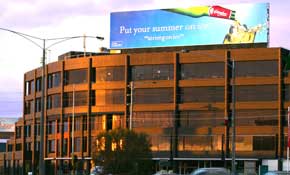
The world of outdoor media, from billboards to signs at stations, shopping centres, on buses and trams and airports, is about to experience a revolution and the impact is likely to flow through to the large-format printing industry. The big winners could include general commercial printers, not just the club of outdoor specialists. It all comes down a $10 million unique measurement tool developed by the Outdoor Media Association (OMA). If forecasts are right, there could be lots of work coming through.
It’s called the MOVE (Measurement of Outdoor Visibility and Exposure) system. It is designed to identify exactly how many people will see an outdoor advertisement. The system is a world first, seeking to do what audits do to track newspaper and magazines readership and what people-meters do to track TV viewing figures. But even better, it’s likely to have a seismic impact on the advertising industry.
The OMA took five years to develop the system. It sent people out and tracked their movements. Some went by train, some walked and others drove. It also equipped them with special goggles fitted with two cameras. One took shots of what they were looking at, the other tracked eye moments. As a result, the system could identify what signs people were looking at.
This is completely different from devices such as TV people-meters, or print media audits, which track the potential audience with the standard measure of Opportunity To See (OTS). Using OTS, a media buyer might know how many people could buy a magazine or newspaper, or watch a TV program. But there is no guarantee they will be looking at the ads.
With a newspaper or magazine, the reader might just ignore it and continue reading. A television viewer might head out the room to make a coffee or fix a sandwich when the ads come on, or channel surf. Indeed, Channel Ten has recently announced it will pull out of the Free TV revenue share figures, citing “serious concerns” over their accuracy. The MasterChef network pulled in revenue of $402.23m for the six months to June, an increase of 21.24% compared with the same period last year but Ten’s ratings went up just 0.5%. TV measurement tools seem to be at odds with amount of advertising coming in.
Even internet tracking systems, often praised as the Holy Grail in terms of return on marketing investment, mostly only track clicks and don’t capture the number of eyeballs on an ad.
The MOVE system, on the other hand, uses the measurement Likelihood To See (LTS). That is to say, people who would be actually glancing, or even gazing, at the sign and taking it in. And unlike similar measurement systems in the UK and US, MOVE looks at all the formats for ads, not just billboards on roads.
OMA chief executive Charmaine Moldrich says all this makes MOVE different from any other audience measurement system. It is suited for an industry that has 63,000 signs around the country. While the rest of the country has been struggling to recover from the global financial crisis, the industry reported a 22% increase in sales in the second quarter this year, compared with the same period in 2009. Net revenue climbed to $110m compared with $90m in 2009. In the seven years leading up to last year, the $500m out-of-home industry grew 74%.
$200m windfall
Moldrich expects MOVE will accelerate sales. She expects it will help the industry grow at least 2%, or by another $200m, over the next three years. “What we give you is not circulation nor do we give you readership. We tell you who is actually landing on your page.” Moldrich says.
“It’s not a black box that sits on someone’s television and it’s not the amount of newspapers you sell. With all the other formats, there are some things at the end that you attach or count. With us, we have got 63,000 faces.
“It’s the last broadcast medium that’s available to pedestrians, to shoppers, to people driving in their cars, to people on buses, to people on trains. We have used many data sets to configure what comes out the other end.”
She says it is even more rigorous than online measurement systems, which do not evaluate how many people actually look at the ads. “It’s hard to make comparisons but I’m online all the time. Ask me about the last online ad I saw and I would say I have no bloody idea. You can tell how many unique users there are on the page but do they actually look at your ad? Out-of-home is not an opt-out or opt-in medium. It’s part of your day-to-day routine. If you do something routine, you will pass a billboard or a bus shelter or some out-of-home format along your way.”
She says the impact may well flow through to the rest of the printing industry. “Of course it will influence printing because what MOVE will do is increase sales. As an audience measurement system, what we are trying to do with MOVE is give client and buyers the information that they have been seeking that outdoor as an industry works for them. It’s a return on investment.
“If you extrapolate what we are getting, hopefully more people will be buying advertising, which means more people will be printing.”
Joana Barros, national marketing manager for street furniture advertising firm Adshel, says outdoor media needed to have a rigorous measurement system.
“Most people know outdoor is a great medium to advertise on but there has been very little actual information to prove outdoor reaches who we say it reaches. It also means we are able to compete with other media more effectively. Now when we go to the negotiating table, we are all speaking the same language,” Barros says.
“Previously when we would go to negotiate with media agencies, a lot of the conversations were around reach and frequency. Obviously when you were buying other media such as print and TV and radio, they were all speaking that kind of language and outdoor was excluded from those kinds of conversations. Now we can be much more confident in those negotiations.”
Barros says that as a result, Adshel now builds MOVE into its campaigns. “From a financial perspective, we have gone one step further and provide guarantees with all our campaigns that you will receive a certain level of reach and frequency. There is also a cost per thousand guarantee.”
Media agencies have also taken to the new system. Ben Willee, managing partner of the Melbourne office of Ikon Communications, says that with good quality freeway sites demanding $30,000 a month, clients want more measurability. They want to know how much bang they get for their buck. MOVE was important as a tool that stacked up against other measurement systems.
He says MOVE has plusses and minuses. “The difficulty with these systems is that you can never compare apples with apples but it adds a layer of credibility to an industry that did in the past had a reputation for being quite cowboy-ish. They have spent an enormous amount of time and money coming up with a methodology that is robust, that is reasonably easy to work with and takes into account the enormous complexity of measuring different formats of outdoors in different environments,” says Willee.
He adds that one could argue MOVE was both better and worse than some of the other measurement tools.
“It’s worse in the sense that it’s very complex and the complexity makes it difficult for simple media buyers like me to understand,” he says. “But then, compared with some of the internet measurement tools, it’s far more robust. Some internet measures can’t cope with the sheer volume of websites and what people’s online habits are.”
Despite its spectacular growth, Willee says outdoor media still only accounts for 3% of the advertising dollar. He believes MOVE could give the sector 20-25% growth.
Come together
Cactus Imaging general manager Nigel Spicer says MOVE has brought different companies and interests together. Part of the problem, he says, is that players in the industries have traditionally pursued their own agendas instead of working together.
“The issue is that for a number of years, there hasn’t been an accepted measurement across the board that’s accepted by all the agencies and media companies. Everyone has tended to do their own thing,” Spicer says.
“This is across the board. It’s driven by the OMA so the integrity and credibility will be very useful for the industry.”
According to Leonie Collins, the general manager of marketing for Australia and New Zealand at Eye, which claims to be Australia’s leading out-of-home media supplier, MOVE has brought different players in the print industry together. This is no small achievement in a sector notorious for its inability to unite around key issues.
Part of the secret, she says, is that the OMA board comprises representatives from different outdoor media companies, all major operators. Its chairman Steve McCarthy is the chief executive officer of Adshel. Other board members come from Goa billboards, APN Outdoor, JCDecaux, Bishopp Outdoor and Ooh Media.
This means different players with different agendas have been speaking with one voice to develop MOVE. The unusual unanimity has helped them create a system that measures all the formats that the board members represent. It has never been done anywhere else in the world.
“It’s one of the few times you will see media operators coming together and agreeing on a path,” Collins says. “They seem to be making head roads there.”
Eye has the greatest coverage of formats measured by MOVE with roadside billboards around the country, advertising rights at 100 shopping centres and shopping centre car parks throughout Australia, point-of-purchase merchandising signage, advertising signage at universities and signage at five domestic airports.
Collins says MOVE will give the outdoor media companies a real competitive advantage as it gives a more accurate assessment than tools used by other media. “It gives us a measurement system that is probably at this point in time the most superior measurement system in the world.”
“It would certainly attract new advertisers to outdoor that haven’t previously been on. With MOVE, we are looking to grow the share of the revenue pie and acquiring more advertising share from other media.”
An increased share of the pie means more work for the industry. But this could only be achieved with different companies with different agendas working together and developing a blueprint that would cover each of their formats.
Yes, it was hard work – it took them five years. But they got there. This illustrates just what can be done when players collaborate to grow the sector. The challenge for the broader printing industry is to adopt similar models that bring different players together to tackle crunch issues.
Comment below to have your say on this story.
If you have a news story or tip-off, get in touch at editorial@sprinter.com.au.
Sign up to the Sprinter newsletter


